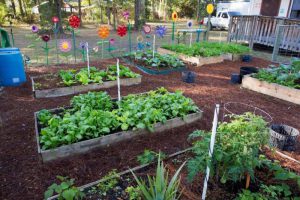
Okaloosa County Master Gardener Margaret Stewart will offer a free lecture on raised bed gardening this Wednesday, June 19.
This hour-long presentation titled Thinking Inside the Box begins at 10 a.m. and will be held at the Extension Office located at 3098 Airport Road in Crestview, Florida.
Margaret will share small-space vegetable gardening techniques such as succession planting and use of vertical supports, which allows you to grow more in less space.
Seating is limited for this seminar and reservations are required. Please call the UF/IFAS Okaloosa County Extension Office at 850-689-5850 or email achisholm@myokaloosa.com to reserve your seat.
Whether you grow tomatoes in a traditional in-ground garden, raised bed or in containers, there are common problems that occur with tomato fruit that are not caused by diseases or insects. These problems are usually easier to prevent than to cure.
Willie Chance, former Extension Vegetable Crops Specialist in Georgia, describes the below common tomato problems.

Blossom-end rot is a serious problem of ripening tomatoes. As the fruit ripens, the blossom-end turns dry, brown and leathery. The spot is sunken and these tomatoes can ripen before others. It is caused by a calcium deficiency in the fruit and can be prevented by the control of nutrition and watering.
Fruit cracking can be caused by periods of fast growth during times of high temperature and moisture supply or by rains after a dry period. Not all cracking can be avoided but you can lessen its severity by mulching and maintaining an even water supply.
Uneven ripening can be caused by several factors including nutrition, high temperature and disease. The most common cause in the home garden is probably too high nitrogen rates and low potassium rates. One wall or one portion of the tomato will remain gray or white after the rest of the tomato turns red. The best control is to take a soil sample and fertilize accordingly.

Sunscald appears as a white-blistered area on the top of the tomato. The area can turn leathery and be invaded by rots. To control, do not prune heavily and maintain nutrition and pest control so as to provide a good leafy cover for the fruits.
More information on growing tomatoes and vegetable gardening is available on line at http://edis.ifas.ufl.edu/pdffiles/hs/hs20000.pdf, https://sfyl.ifas.ufl.edu/lawn-and-garden/vegetable-gardening or from the UF/IFAS Extension Office in your County.
 0
0
